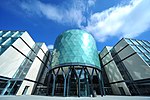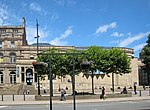Leeds City Museum
1819 establishments in EnglandArchaeological museums in EnglandCity museums in the United KingdomCuthbert Brodrick buildingsEthnographic museums in England ... and 7 more
Grade II listed buildings in West YorkshireGrade II listed museum buildingsLocal museums in West YorkshireMuseums established in 1819Museums in LeedsNatural history museums in EnglandUse British English from August 2015

Leeds City Museum, originally established in 1819, reopened in 2008 in Leeds, West Yorkshire, England. It is housed in the former Mechanics' Institute built by Cuthbert Brodrick, in Cookridge Street (now Millennium Square). It is one of nine sites in the Leeds Museums & Galleries group. Admission to the museum is free of charge. Special exhibitions are hosted alongside a collection of displays from the Leeds Archive.
Excerpt from the Wikipedia article Leeds City Museum (License: CC BY-SA 3.0, Authors, Images).Leeds City Museum
Millennium Square, Leeds Woodhouse
Geographical coordinates (GPS) Address Phone number Website External links Nearby Places Show on map
Geographical coordinates (GPS)
| Latitude | Longitude |
|---|---|
| N 53.801666666667 ° | E -1.5469444444444 ° |
Address
Leeds City Museum
Millennium Square
LS2 8BH Leeds, Woodhouse
England, United Kingdom
Open on Google Maps










